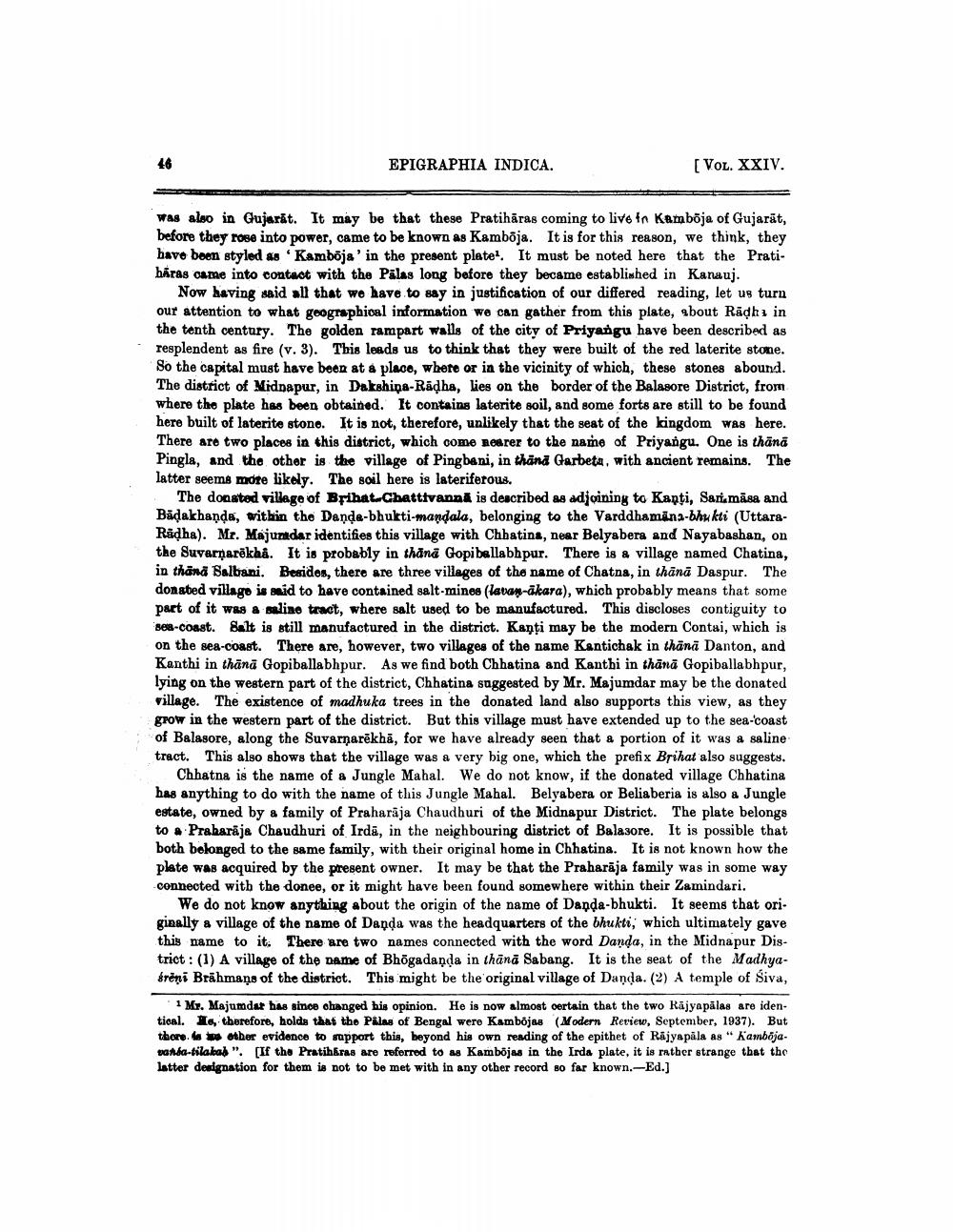________________
EPIGRAPHIA INDICA.
[Vol. XXIV.
was also in Gujarat. It may be that these Pratihāras coming to live in Kamboja of Gujarāt, before they rose into power, came to be known as Kamboja. It is for this reason, we think, they have been styled as Kamboja' in the present platel. It must be noted here that the Pratiháras came into contact with the Palas long before they became established in Kanauj.
Now having said all that we have to say in justification of our differed reading, let us turn our attention to what geographical information we can gather from this plate, about Rādhu in the tenth century. The golden rampart walls of the city of Priyangu have been described as resplendent as fire (v. 3). This leads us to think that they were built of the red laterite stone. So the capital must have been at a place, where or in the vicinity of which, these stones abound. The district of Midnapur, in Dakshina-Rādha, lies on the border of the Balasore District, from where the plate has been obtained. It contains laterite soil, and some forts are still to be found here built of laterite stone. It is not, therefore, unlikely that the seat of the kingdom was here. There are two places in this district, which come nearer to the name of Priyangu. One is thānā Pingla, and the other is the village of Pingbani, in thand Garbeta, with ancient remains. The latter seems more likely. The soil here is lateriferous,
The donated village of Bfihat.Chatttvannā is described as adjoining to Kanti, Sari māsa and Bädakhanda, within the Danda-bhukti-mandala, belonging to the Varddhamana-bhukti (UttaraRādha). Mr. Majumdar identifies this village with Chhatina, near Belyabera and Nayabashan, on the Suvarnarēkhå. It is probably in thana Gopibellabhpur. There is & village named Chatina, in thāna Balbani. Besides, there are three villages of the name of Chatna, in thānā Daspur. The donated village is sid to have contained salt-mines (lavan-ākara), which probably means that some part of it was a saline tract, where salt used to be manufactured. This discloses contiguity to 8ea-coast. Salt is still manufactured in the district. Kaņţi may be the modern Contai, which is on the sea-coast. There are, however, two villages of the name Kantichak in thānā Danton, and Kanthi in thānā Gopiballabhpur. As we find both Chhatina and Kanthi in thānā Gopiballabhpur, lying on the western part of the district, Chhatina suggested by Mr. Majumdar may be the donated village. The existence of madhuka trees in the donated land also supports this view, as they grow in the western part of the district. But this village must have extended up to the sea-coast of Balasore, along the Suvarnarēkhā, for we have already seen that a portion of it was a saline tract. This also shows that the village was a very big one, which the prefix Brihat also suggests.
Chhatna is the name of a Jungle Mahal. We do not know, if the donated village Chhatina has anything to do with the name of this Jungle Mahal. Belyabera or Beliaberia is also a Jungle estate, owned by a family of Praharāja Chaudhuri of the Midnapur District. The plate belongs to a Praharaja Chaudhuri of Irdā, in the neighbouring district of Balasore. It is possible that both belonged to the same family, with their original home in Chhatina. It is not known how the plate was acquired by the present owner. It may be that the Praharāja family was in some way connected with the donee, or it might have been found somewhere within their Zamindari.
We do not know anything about the origin of the name of Danda-bhukti. It seems that ori. ginally a village of the name of Danda was the headquarters of the bhukti, which ultimately gave this name to it. There are two names connected with the word Danda, in the Midnapur District : (1) A village of the name of Bhõgadaņda in thānā Sabang. It is the seat of the Madhyafreni Brāhmaṇs of the district. This might be the original village of Danda. (2) A temple of Siva,
1 Mr. Majumdat has since changed his opinion. He is now almost oertain that the two Rajyapālas are identical. 6, therefore, holds that the Palas of Bengal were Kambojas (Modern Review, September, 1937). But there.
W e other evidence to support this, beyond his own reading of the epithet of Rajyapāla as " Kambojavana-tilalbal". [If tha Pratihbras are referred to as Kambojas in the Irda plate, it is rather strange that the latter designation for them is not to be met with in any other record so far known.-Ed.)




